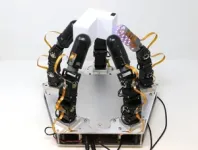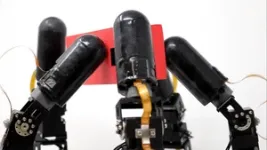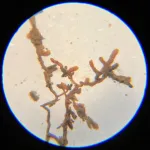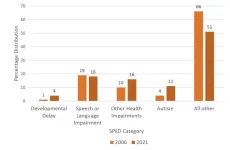(Press-News.org) New York, NY—April 27, 2023—Think about what you do with your hands when you’re home at night pushing buttons on your TV’s remote control, or at a restaurant using all kinds of cutlery and glassware. These skills are all based on touch, while you’re watching a TV program or choosing something from the menu. Our hands and fingers are incredibly skilled mechanisms, and highly sensitive to boot.
Robotics researchers have long been trying to create “true” dexterity in robot hands, but the goal has been frustratingly elusive. Robot grippers and suction cups can pick and place items, but more dexterous tasks such as assembly, insertion, reorientation, packaging, etc. have remained in the realm of human manipulation. However, spurred by advances in both sensing technology and machine-learning techniques to process the sensed data, the field of robotic manipulation is changing very rapidly.
VIDEO: https://youtu.be/mYlc_OWgkyI
Highly dexterous robot hand even works in the dark
Researchers at Columbia Engineering have demonstrated a highly dexterous robot hand, one that combines an advanced sense of touch with motor learning algorithms in order to achieve a high level of dexterity.
As a demonstration of skill, the team chose a difficult manipulation task: executing an arbitrarily large rotation of an unevenly shaped grasped object in hand while always maintaining the object in a stable, secure hold. This is a very difficult task because it requires constant repositioning of a subset of fingers, while the other fingers have to keep the object stable. Not only was the hand able to perform this task, but it also did it without any visual feedback whatsoever, based solely on touch sensing.
In addition to the new levels of dexterity, the hand worked without any external cameras, so it's immune to lighting, occlusion, or similar issues. And the fact that the hand does not rely on vision to manipulate objects means that it can do so in very difficult lighting conditions that would confuse vision-based algorithms--it can even operate in the dark.
“While our demonstration was on a proof-of-concept task, meant to illustrate the capabilities of the hand, we believe that this level of dexterity will open up entirely new applications for robotic manipulation in the real world,” said Matei Ciocarlie, associate professor in the Departments of Mechanical Engineering and Computer Science. “Some of the more immediate uses might be in logistics and material handling, helping ease up supply chain problems like the ones that have plagued our economy in recent years, and in advanced manufacturing and assembly in factories.”
Leveraging optics-based tactile fingers
In earlier work, Ciocarlie’s group collaborated with Ioannis Kymissis, professor of electrical engineering, to develop a new generation of optics-based tactile robot fingers. These were the first robot fingers to achieve contact localization with sub-millimeter precision while providing complete coverage of a complex multi-curved surface. In addition, the compact packaging and low wire count of the fingers allowed for easy integration into complete robot hands.
Teaching the hand to perform complex tasks
For this new work, led by CIocarlie’s doctoral researcher, Gagan Khandate, the researchers designed and built a robot hand with five fingers and 15 independently actuated joints--each finger was equipped with the team’s touch-sensing technology. The next step was to test the ability of the tactile hand to perform complex manipulation tasks. To do this, they used new methods for motor learning, or the ability of a robot to learn new physical tasks via practice. In particular, they used a method called deep reinforcement learning, augmented with new algorithms that they developed for effective exploration of possible motor strategies.
Robot completed approximately one year of practice in only hours of real-time
The input to the motor learning algorithms consisted exclusively of the team’s tactile and proprioceptive data, without any vision. Using simulation as a training ground, the robot completed approximately one year of practice in only hours of real-time, thanks to modern physics simulators and highly parallel processors. The researchers then transferred this manipulation skill trained in simulation to the real robot hand, which was able to achieve the level of dexterity the team was hoping for. Ciocarlie noted that “the directional goal for the field remains assistive robotics in the home, the ultimate proving ground for real dexterity. In this study, we've shown that robot hands can also be highly dexterous based on touch sensing alone. Once we also add visual feedback into the mix along with touch, we hope to be able to achieve even more dexterity, and one day start approaching the replication of the human hand.”
Ultimate goal: joining abstract intelligence with embodied intelligence
Ultimately, Ciocarlie observed, a physical robot being useful in the real world needs both abstract, semantic intelligence (to understand conceptually how the world works), and embodied intelligence (the skill to physically interact with the world). Large language models such as OpenAI’s GPT-4 or Google’s PALM aim to provide the former, while dexterity in manipulation as achieved in this study represents complementary advances in the latter.
For instance, when asked how to make a sandwich, ChatGPT will type out a step-by-step plan in response, but it takes a dexterous robot to take that plan and actually make the sandwich. In the same way, researchers hope that physically skilled robots will be able to take semantic intelligence out of the purely virtual world of the Internet, and put it to good use on real-world physical tasks, perhaps even in our homes.
The paper has been accepted for publication at the upcoming Robotics: Science and Systems Conference (Daegu, Korea, July 10-14, 2023), and is currently available as a preprint.
About the Study
Conference: Robotics: Science and Systems Conference (Daegu, Korea, July 10-14, 2023)
The study is titled “Sampling-based Exploration for Reinforcement Learning of Dexterous Manipulation.”
Authors are all from Columbia Engineering: Gagan Khandate and Tristan Luca Saidi (Computer Science), Siqi Shang, Eric Chang, Johnson Adams, and Matei Ciocarlie (Mechanical Engineering). The tactile sensors were developed in collaboration with Ioannis Kymissis (Electrical Engineering).
This work was supported in part by the Office of Naval Research grant N00014-21-1-4010 and the National Science Foundation grant CMMI-2037101.
The authors declare no financial or other conflicts of interest.
###
END
Highly dexterous robot hand can operate in the dark -- just like us
Columbia Engineers design a robot hand that is the first device of its kind to join advanced sense of touch with motor-learning algorithms--it doesn’t rely on vision to manipulate objects
2023-04-27
ELSE PRESS RELEASES FROM THIS DATE:
Texas Tech researchers contribute to groundbreaking mammal research
2023-04-27
Why was Balto, a famous sled dog from the 1920s, able to survive the unforgiving conditions of Alaska? It was one of many findings uncovered through the Zoonomia Project, which involved researchers from Texas Tech University.
More than a dozen researchers from the Department of Biological Sciences were among the major collaborators in the Zoonomia Project who will publish their multi-year comparative genomic analysis of mammals and the influence of genetic change on health and disease in the April 28 issue of Science magazine.
The laboratory of David Ray, professor and associate chair of the department, studies transposable elements ...
Snowballing effects of beech leaf disease hurt helpful root fungi
2023-04-27
The American beech, Fagus grandifolia, is a North American staple and the dominant species in many northeastern forests. In 2012, a new disease was first spotted, infecting trees in northeastern Ohio. The worst afflicted had dark banding on their leaves, which emerged crumpled and leathery in the spring. Not until 2018 would experts discover the nematode pest, Litylenchus crenatae mccannii, overwintering in the buds of infected trees.
As it marches across the continent, researchers are still ...
Higher rates of autism and attention deficit/hyperactivity disorder in American children
2023-04-27
In a recent publication released by PubMed, American scientists led by Dr. Dufault at the Food Ingredient and Health Research Institute, reported alarming increases in the numbers of children requiring special education services. While student enrollment in US schools remained stable from 2006-2021, the percentage of children receiving special education services increased 10.4%. Of the three disability categories under which children with autism may receive services, autism caseload percentages tripled jumping from 4% to 11% while developmental delay caseload ...
Improving geriatric surgical quality is feasible for a wide range of hospitals
2023-04-27
Key takeaways
Feasible for small and large hospitals: Pilot institutions in the study included community hospitals and academic medical centers representing every region of the United States.
Geriatric surgical patients are a growing population: American College of Surgeons standards for geriatric surgery address a growing population that most hospitals serve.
Standards help address barriers to implementation: ACS geriatric surgery standards help hospitals identify and address challenges to providing optimal care, including staffing, manpower, and lack of geriatricians in many hospitals.
CHICAGO: ...
Scripps Research preclinical study finds insomnia drug blocks oxycodone relapse
2023-04-27
LA JOLLA, CA—The insomnia drug suvorexant (Belsomra®) might be an effective treatment for opioid use disorder, according to a preclinical study from Scripps Research.
In the study, published April 27, 2023, in Frontiers in Pharmacology, the Scripps Research scientists found that suvorexant reduced prescription opioid intake and helped protect against relapse in rats modeling opioid use disorder (OUD). If the results translate to humans in clinical trials, the insomnia drug could offer a promising approach for the millions of people who have OUD.
“Our results suggest that repurposing suvorexant could be a good strategy for reducing drug intake and blocking relapse in cases ...
Calling all canines: Help sniff out the dangerous spotted lanternfly
2023-04-27
From New York to North Carolina and as far west as Illinois, the invasive spotted lanternfly is causing chaos in many states where agricultural and forestry industries are essential to the economy. It has been estimated that crops and forest production losses caused by insects and pathogens are close to $40 billion a year.
Spotted laternflies, native to mainland China, prey upon 70-plus host plant species, stealing their nutrients with their piercing snouts, called stylets. They are often characterized as “hitchhikers” for their ability to move ...
AGS honors expert & emerging geriatrics leaders at 2023 Annual Scientific Meeting (#AGS23)
2023-04-27
New York (April 27, 2023) – The American Geriatrics Society (AGS) annually honors researchers, clinicians, educators, and emerging health professionals who have made outstanding contributions to high-quality, person-centered care for older adults. This year’s award recipients include 19 leaders representing the breadth of medical disciplines championing care for us all as we age.
Clinical Student Research Award
Matthew Ryan Cosmai
Clinician of the Year Award
Shelley R. McDonald, DO, PhD
David H. Solomon Memorial Public Service Award
Alan Lazaroff, ...
Plastic particles themselves, not just chemical additives, can alter sex hormones
2023-04-27
Amid rising evidence that additives designed to improve plastics also disrupt sex hormones, a Rutgers laboratory trial shows that plastic itself can do likewise when inhaled at moderate levels.
Previous studies focused on chemicals such as bisphenol-A (BPA) that make plastics stiffer or more flexible. These findings spurred ongoing efforts to find safer plastic additives.
The Rutgers study showed that microscale and nanoscale particles (MNPs) of polyamide, a common plastic better known as nylon, produced endocrine-disrupting ...
ATS 2023 International Conference announces late-breaking clinical trials
2023-04-27
April 27, 2023 – One of the most highly-anticipated events at the ATS 2023 International Conference, which kicks off May 19, is the “Breaking News: Clinical Trial Results in Pulmonary Medicine.” Taking place on Monday, May 22, the series of presentations will focus on the latest regarding COPD and asthma treatment.
Register now to hear these presentations live. A question-and-answer period will follow all presentations:
Seralutinib Treatment in Adult Subjects with Pulmonary Arterial Hypertension: Results from the TORREY Study
Effect of Ensifentrine, a Novel PDE3 and PDE4 Inhibitor, on Lung Function, Symptoms and Exacerbations in Patients with COPD: ...
In yeast, altering genetic circuitry that controls how an aging cell dies enhances longevity
2023-04-27
Engineering a synthetic oscillator that cycles between the two deterioration pathways that lead to cell death can slow aging in yeast cells, increasing their longevity by more than 80%, a new study reports. The findings represent a proof-of-concept example of using synthetic biology to reprogram the cellular aging process. Given that the underlying aging pathways are conserved, the findings may one day enable the design of synthetic gene circuits that promote longevity in more complex organisms. Cellular aging is a fundamental and complex biological process ...
LAST 30 PRESS RELEASES:
The (metabolic) cost of life
CFRI special issue call for papers: New Frontiers in Sustainable Finance
HKU Engineering scholar demonstrates the smallest all-printed infrared photodetectors to date
Precision empowerment for brain "eavesdropping": CAS team develops triple-electrode integrated functional electrode for simultaneous monitoring of neural signals and chemical transmitters during sleep
Single-capillary endothelial dysfunction resolved by optoacoustic mesoscopy
HKU three research projects named among ‘Top 10 Innovation & Technology News in Hong Kong 2025’ showcasing excellence in research and technology transfer
NLRSeek: A reannotation-based pipeline for mining missing NLR genes in sequenced genomes
A strand and whole genome duplication–aware collinear gene identification tool
Light storage in light cages: A revolutionary approach to on-chip quantum memories
Point spread function decoupling in computational fluorescence microscopy
BacPhase: Long-insert paired-end sequencing for bin marker construction and genome phasing
GmWOX1 regulates the mediolateral polarity of compound leaves in soybean
ChargeFabrica: An open-source simulation tool that aims to accelerate search for high performance perovskite solar cells
High levels of ADAR overexpression induce abundant and stochastic off-target RNA editing in rice protoplasts
On-demand upgraded recycling of polyethylene and construction of sustainable multifunctional materials based on the "LEGO" strategy
New "Stomata in-sight" system allows scientists to watch plants breathe in real-time
Anorexia nervosa may result in long-term skeletal muscle impairment
Narrative-based performance reviews deemed fairest by employees
New insights reveal how advanced oxidation can tackle emerging water pollutants
New review shows how biomass can deliver low-carbon gaseous fuels at scale
Climate change is quietly rewriting the world’s nitrogen cycle, with high stakes for food and the environment
Study finds SGLT-2 inhibitors linked to lower risk of diabetic foot nerve damage
Microbes may hold the key to brain evolution
Study examines how the last two respiratory pandemics rapidly spread through cities
Gender stereotypes reflect the division of labor between women and men across nations
Orthopedics can play critical role in identifying intimate partner violence
Worms as particle sweepers
Second spider-parasitic mite described in Brazil
January 2026 issues of APA journals feature new research on autism, pediatric anxiety, psychedelic therapy, suicide prevention and more
Private equity acquired more than 500 autism centers over the past decade, new study shows
[Press-News.org] Highly dexterous robot hand can operate in the dark -- just like usColumbia Engineers design a robot hand that is the first device of its kind to join advanced sense of touch with motor-learning algorithms--it doesn’t rely on vision to manipulate objects






